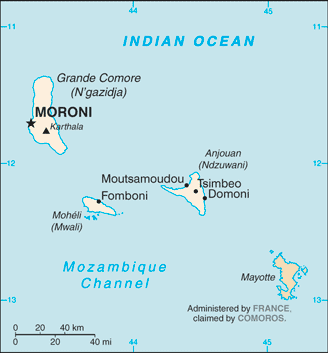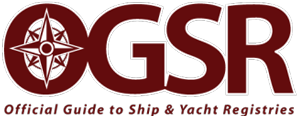Comoros
 Geography
Geography
The Comoro Islands are an archipelago of four islands and several islets located in the Western Indian Ocean about ten to twelve degrees south of the Equator and less than 200 miles off the East African coast. The archipelago is the result of volcanic action along a fissure in the seabed running West-Northwest to East-Southeast. The four major islands are Ngazidja, Mwali, Nzwani, and Mayotte. The total area of the four islands is 785 square miles (2,034 square kilometers).
Population
The total population of the Comoro Islands is estimated to be over 700,000 people today. Over 27% live in urban areas. In recent decades the population was increased by the forced evacuation of Comorians from Madagascar and Zanzibar.
The inhabitants are a blend of various peoples of the Indian Ocean littoral. African, Malagasy, and Arabic features are clearly evident. Maritime commerce before entry of Europeans into the Indian Ocean brought Comorians into contact with peoples from southern Africa to Southeast Asia. Since the end of the fifteenth century European influence has also impacted upon Comorian life.
Language
The official languages of The Union of the Comoros are French and Arabic. French is the language of government while Arabic is the language of Islam, the major religion in the Republic. French is used as the official language on the island of Mayotte.
In daily life, most people speak one or more varieties of Comorian, the language group indigenous to the Islands. It is closely related to the Swahili of the East African coast. Comorian is typical of a Bantu language with a large number of noun classes and an elaborate set of verb tenses and aspects. For centuries, people have used Arabic script to write Comorian and there is an attempt presently to normalize orthography for writing the varieties of the language in Roman script.
The rich vocabulary of Comorian has been enhanced by the borrowing of words from many other languages. Since Comorians have been involved in maritime trade for a thousand years or more, they have come into contact with a number of different peoples and their language reflects this contact. Words of Indian, Persian, Arabic, Portuguese, English, and French origin have been added to those of African ancestry.
There are four varieties of Comorian spoken in the Islands: Shingazidja, Shimwali, Shinzwani, and Shimaore, each one named for the primary island on which it is spoken.
Economy
Traditionally, seaborne trade played an important role in the Islands ' economy. Today, agriculture is the principal economic activity with crops grown both for domestic consumption and export. The major food crops are cassava, coconut, bananas, rice, sweet potatoes, pulses, and corn. Vanilla, ylang-ylang, cloves, and copra have been the major export crops.
Some animal husbandry is undertaken by individual farmers and a small scale fishing industry exists. Coelecanth specimens provided some income for fishermen and the government. This fish was thought by western scientists to have been extinct for 70 million years but has been caught by local fishermen for years. At one time it was sold to the local government and resold to museums and research centers all over the world.
There is a small tourist industry on the Islands which had been recently promoted by South African interests.
France has been the major trading partner of the Comoros. The Islands have a relatively large negative trade balance and the government has been for many years dependent upon external aid.
The currency of the country is the Comorian franc. Its value is tied to the US dollar at 378.7 Comorian francs to 1 US Dollar. There are banks on the islands of Ngazidja, Nzwani, and Maore but no bank on Mwali.
The Union of Comoros Maritime Shipping Act 2001 provides a modern legal framework for the operation of a competitive International Ship Registry.
[Source]

